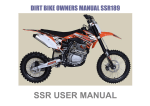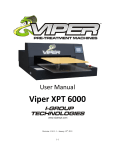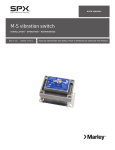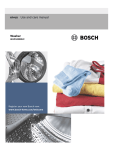Download TROUBLESHOOTING
Transcript
AX–11 AUTOMATIC TRANSAXLE – TROUBLESHOOTING TROUBLESHOOTING Trouble occurring in the ECT can stern from one of three sources: the engine, the ECT electronic control unit or the transmission itself. Before troubleshooting, determine in which these three sources the problem lies, and begin troubleshooting with the simplest operation, gradually working up in order or difficulty. BASIC TROUBLESHOOTING Before troubleshooting and ECT, first determine whether the problem is electrical or mechanical. To do this, just refer to the basic troubleshooting flow–chart provided below. If the cause is already known, using the basic troubleshooting chart below along with the general troubleshooting chart on the following page should speed the procedure. Bad Preliminary Check (See page AX–14) Bad Repair or Replace Read Diagnostic Code (See page AX–18) Bad Manual Shifting Test (See page AX–23) Mechanical System Tests (See page AX–36) Bad Electrical Control System Check (See page AX–25) Bad Repair Transaxle Bad Matrix Chart (See page AX–46) Repair or Replace AX–12 AUTOMATIC TRANSAXLE – TROUBLESHOOTING GENERAL TROUBLESHOOTING NOTICE: Refer to A241 E Automatic Transaxle Repair Manual (Pub. No. RM291 U) when * mark appears in the column for page numbers. Problem Possible cause Remedy Page Fluid discolored or smells burnt Fluid contaminated Torque converter faulty Transaxle faulty Replace fluid Replace torque converter Disassemble and inspect transaxle AX–14 AX–66 Vehicle does not move in any forward range or reverse Shift cable out of adjustment Valve body or primary regulator faulty Parking lock pawl faulty Torque converter faulty Converter drive plate broken Oil strainer intake screen blocked Transaxle faulty Adjust shift cable Inspect valve body Inspect parking lock pawl Replace torque converter Replace drive plate Clean screen Disassemble and inspect transaxle AX–15 AX–66 AX–66 Shift lever position incorrect Shift cable out of adjustment Manual valve and lever faulty Transaxle faulty Adjust shift cable Inspect valve body Disassemble and inspect transaxle AX–15 Harsh engagement into any drive range Throttle cable out of adjustment Valve body or primary regulator faulty Accumulator pistons faulty Transaxle faulty Adjust throttle cable Inspect valve body inspect accumulator pistons Disassemble and inspect transaxle AX–15 Delayed 1–2, 2–3 or 3–O/D up–shift, or down–shifts from O/D–3 or 3–2 and shift back to O/D or 3 Electronic control faulty Valve body faulty Solenoid valve faulty Throttle cable out of adjustment Inspect electronic control Inspect valve body Inspect solenoid valve Adjust throttle cable AX–25 AX–33 AX–15 Slips on 1–2, 2–3 or 3–O/D up–shift, or slips or shudders on acceleration Shift cable out of adjustment Throttle cable out of adjustment Valve body faulty Solenoid valve faulty Transaxle faulty Adjust shift cable Adjust throttle cable Inspect valve body Inspect solenoid valve Disassemble and inspect transaxle AX–15 AX–15 AX–33 Drag, binding or tie–up on 1–2, 2–3, or 3–O/D up–shift Shift cable out of adjustment Valve body faulty Transaxle faulty Adjust shift cable Inspect valve body Disassemble and inspect transaxle AX–15 ’. ¿n–r:¿:%r, AX–13 AUTOMATIC TRANSAXLE – TROUBLESHOOTING NOTICE: Refer to A241 E Automatic Transaxle Repair Manual (Pub. No. RM291 U) when * mark appears in the column for page numbers. Problem Possible cause Remedy Page No lock–up in 2nd, 3rd or O/D Electronic control faulty Valve body faulty Solenoid valve faulty Transaxle faulty Inspect electronic control Inspect valve body Inspect solenoid valve Disassemble and inspect transaxle AX–25 AX–33 Harsh down–shift Throttle cable out of adjustment Throttle cable and cam faulty Accumulator pistons, faulty Valve body faulty Transaxle faulty Adjust throttle cable Inspect throttle cable and cam Inspect accumulator pistons Inspect valve body Disassemble and inspect transaxle AX–15 No down–shift when coasting Valve body faulty Solenoid valve faulty Electronic control faulty Inspect valve body Inspect solenoid valve Inspect electronic control AX–33 AX–25 Down–shift occurs too quickly or too late while coasting Throttle cable faulty Valve body faulty Transaxle faulty Solenoid valve faulty Electronic control faulty Inspect throttle cable Inspect valve body Disassemble and inspect transaxle Inspect solenoid valve Inspect electronic control AX–15 No O/D–3, 3–2 or 2–1 kick–down Solenoid valve faulty Electronic control faulty Valve body faulty Throttle cable out of adjustment Inspect solenoid valve Inspect electronic control Inspect valve body Adjust throttle cable AX–33 AX–25 AX–15 No engine braking in 2 or L range Solenoid valve faulty Electronic control faulty Valve body faulty Transaxle faulty Inspect solenoid valve Inspect electronic control Inspect valve body Disassemble and inspect transaxle AX–33 AX–25 Vehicle does not hold in P range Shift cable out of adjustment Parking lock pawl and spring faulty Adjust shift cable Inspect cam and spring AX–15 AX–33 AX–25 AX–14 AUTOMATIC TRANSAXLE – TROUBLESHOOTING PRELIMINARY CHECK 1. CHECK TRANSAXLE FLUID LEVEL HINT: The vehicle must have been driven so that the engine and transaxle. are at normal operating tem– perature. (fluid temperature: 70–80°C or 158–176°F) (a) Park the vehicle on a level surface, set the parking brake. (b) With the engine idling and the brake pedal depressed, shift the shift lever into each gear from the P range to L range smoothly and return to P range. HINT: Depress the brake pedal. (c) Pull out the transaxle dipstick and wipe it clean. (d) Push it back fully into the tube. (e) Pull it out and check that the fluid level is in the HOT range. If the level is at the low side of the hot range, add fluid. Fluid type: ATF DEXRONII NOTICE: Do not overfill. 2. CHECK FLUID CONDITION If the fluid smells burnt or is black, replace it. 3. REPLACE ATF NOTICE: Do not overfill. (a) Remove the drain plug, gasket and drain the fluid. (b) Install a new gasket and the drain plug securely. (c) Add new fluid through the filler tube. Fluid: ATF DEXRONII Capacity: 8.0 liters (8.5 US qts, 7.0 Imp.qts) Drain and refill: 3.3 liters (3.5 US qts, 2.9 Imp.qts) (d) Start the engine and shift the selector into all posi– tions from P through L and then shift into P. (e) With the engine idling, check the fluid level. Add fluid up to the COOL level on the dipstick. AX–15 AUTOMATIC TRANSAXLE – TROUBLESHOOTING (f) Check the fluid level with the normal fluid temperature (158–176°F or 70–80°C) and add as necessary. NOTICE: Do not overfill. 4. INSPECT AND ADJUST THROTTLE CABLE (a) Check that the throttle valve is fully closed. (b) Check that the inner cable is not slack. (c) Measure the distance between the outer cable end and stopper on the cable. Standard boot and cable stopper distance: 0–1 mm (0–0.04 in.) If the distance is not standard, adjust the cable by the adjusting nuts. 5. INSPECT AND ADJUST SHIFT CABLE When shifting the shift lever from the N position to other posi– tions, check that the lever can be shifted smoothly and accurately to each position and that the posi– tion indicator correctly indicates the position. If the indicator is not aligned with the correct position, carry out the following adjustment procedure. (a) Remove the No.1 engine under cover. (b) Loosen the swivel nut on manual shift lever. (c) Push the manual shift lever fully toward–the right side of the vehicle. (d) Return the lever two notches to NEUTRAL position. (e) Set the shift lever to N. (f) While holding the lever lightly toward the R range side, tighten the swivel nut. (g) Install the No.1 engine under cover. AX–16 AUTOMATIC TRANSAXLE – TROUBLESHOOTING 6. ADJUST PARK/NEUTRAL SWITCH If the engine will start with the shift selector in any range other than N or P range, adjustment is required. (a) Loosen the park/neutral switch bolts and set the shift selector to the N range. (b) Align the groove and neutral basic line. (c) Hold in position and tighten the bolts. Torque: 5.4 N–m (55 kgf–cm, 48 in.–M) 7. INSPECT IDLE SPEED (N RANGE) Idle speed: 800 rpm AX–17 AUTOMATIC TRANSAXLE – TROUBLESHOOTING DIAGNOSIS SYSTEM DESCRIPTION 1. A self–diagnosis function is built into the electrical control system. Warning is indicated by the overdrive OFF indicator light. HINT: Warning and diagnostic codes can be read only when the overdrive switch is ON. If OFF, the overdrive OFF light is lit continuously and will not blink. (a) If a malfunction occurs within the speed sensors (No. 1 or 2) or solenoids (No. 1 or 2), the overdrive OFF light will blink to warn the driver. However, there will be no warning of a malfunction with lock–up solenoid. (b) The diagnostic code can be read by the number of blinks of the overdrive OFF indicator light when ter– minals TE, and E, are connected. (See page AX–25) (c) The throttle position sensor or brake signal are not indicated, but inspection can be made by checking the voltage at terminal TT of the data link connector. (d) The signals to each gear can be checked by measuring the voltage at terminal TT of the data link connector while driving. 2. The diagnostic code (trouble code) is retained in memory by the PCMT and due to back–up voltage, is not canceled out when the engine is turned off. Con– sequently, after repair, it is necessary to turn the ignition switch off and remove the EFI fuse (1 5A) or disconnect the PCMT connector to cancel out the diagnostic (trouble) code. (See page AX–19) HINT: • • Low battery voltage will cause faulty operation of the diagnosis system. Therefore, always check the battery first. Use a voltmeter and ohmmeter that have an im– pedance of at least 10 k/V. CHECK “O/D OFF” INDICATOR LIGHT 1. Turn the ignition switch ON. 2. The “O/D OFF” light will come on when the O/D switch is placed at OFF. 3. When the O/D switch is set to ON, the “O/D OFF” light should go out. If the “O/D OFF” light flashes when the O/D switch is set to ON, the electronic control system is faulty. AX–18 AUTOMATIC TRANSAXLE – TROUBLESHOOTING READ DIAGNOSTIC CODE 1. TURN IGNITION SWITCH AND O/D SWITCH TO ON Do not start the engine. HINT: Warning and diagnostic codes can be read only when the overdrive switch is ON. If OFF, the overdrive OFF light will light continuously and will not blink. 2. CONNECT TE, AND E1 TERMINALS OF DATA LINK CONNECTOR Using SST, connect terminals TE, and E1 of the datalink connector. SST 09843–18020 3. READ DIAGNOSTIC CODE Read the diagnostic code as indicated by the number of times the O/D OFF light flashes. (Diagnostic Code Indication) • If the system is operating normally, the light will flash 2 times par second. • In the event of a malfunction, the light will flash 1 time par second. The number of blinks will equal the first number and, after 1.5 seconds pause, the second number of the two digit diagnostic code. If there are two or more codes, there will be a 2.5 seconds pause between each. HINT: In the event of several trouble codes occurring simultaneously, indication will began from the smaller value and continue to the larger. 4. REMOVE SST AX–19 AUTOMATIC TRANSAXLE – TROUBLESHOOTING DIAGNOSTIC CODES Code No. Light Pattern Diagnosis System Normal Defective No. 1 speed sensor (in combination meter)– severed wire harness or short circuit Defective No. 2 speed sensor (in ATM)– severed wire harness or short circuit Severed No. 1 solenoid or short circuit– severed wire harness or short circuit Severed No.2 solenoid or short circuit– severed wire harness or short circuit Severed lock–up solenoid or short circuit– severed wire harness or short circuit HINT: If codes 62, 63, or 64 appear, there is an electrical malfunction in the solenoid. Causes due to mechanical failure, such as a stuck valve, will not appear. AX–20 AUTOMATIC TRANSAXLE – TROUBLESHOOTING CANCEL OUT DIAGNOSTIC CODE 1. After repair of the trouble area, the diagnostic code retained in memory by the PCMT must be canceled by removing the EFI fuse (1 5A) for 10 seconds or more, depending on ambient temperature (the lower the temperature, the longer the fuse must be left out) with the ignition switch OFF. HINT: Cancellation can be also done by removing the battery negative (–) terminal, but in this case other memory systems will be also canceled out. The diagnostic code can be also canceled out by disconnecting the PCMT connector. If the diagnostic code is not canceled out, it will be retained by the PCMT and appear along with a new code in event of future trouble. 2. After cancellation, perform a road test to confirm that a “normal code” is now read on the O/D OFF light. AX–21 AUTOMATIC TRANSAXLE – TROUBLESHOOTING TROUBLESHOOTING FLOW–CHART HINT: • If diagnostic code Nos.42, 61, 62 or 63 are output, the overdrive OFF indicator light will begin to blink immediately to warn the driver. However, an impact or shock may cause the blinking to stop; but the code will still be retained in the PCMT memory until canceled out. • There is no warning for diagnostic code No.64. • In the event of a simultaneous malfunction of both No.1 and No.2 speed sensors, no diagnostic code will appear and the fail–safe system will not function. However, when driving in the D range, the transmission will not up–shift from first gear, regardless of the vehicle speed. Diagnostic code 42 (No. 1 vehicle speed pulse generator circuitry) Check continuity between PCMT connector SPD terminal and body ground. (See page AX–32) Substitute another PCMT. Check No. 1 vehicle speed pulse generator. (See page BE–xx) Repair or replace No. 1 vehicle speed pulse generator. Check wiring between PCMT and combination meter. Diagnostic code 61 (No. 2 vehicle speed pulse generator circuitry) Check continuity between PCMT connector SP2 terminal and body ground. (See page AX–32) Substitute another PCMT. Check No. 2 vehicle speed pulse generator. (See page AX–34) Check wiring between PCMT and No. 2 vehicle speed pulse generator. Repair or replace No. 2 vehicle speed pulse generator. AX–22 AUTOMATIC TRANSAXLE – TROUBLESHOOTING Diagnostic code 62 (No. 1 solenoid circuitry) Check resistance of No. 1 solenoid valve at PCMT connector. (See page AX–33) Substitute another PCMT. Remove the oil pan and check resistance of No. 1 solenoid valve connector and body ground. Resistance: 11–15 Replace No. 1 solenoid valve. Check wiring between No. 1 solenoid valve and PCMT. Diagnostic code 63 (No. 2 solenoid valve circuitry) Check resistance of No. 2 solenoid valve at PCMT connector. (See page AX–33) Substitute another PCMT. Remove the oil pan and check resistance of No. 2 solenoid valve connector and body ground. Resistance: 11–150 Replace No. 2 solenoid valve. Check wiring between No. 2 solenoid valve and PC MT . Diagnostic code 64 (Transaxle converter clutch switch valve circuitry) Check resistance of transaxle converter clutch switch valve at PCMT connector. (See page AX–33) Substitute another PC MT. Remove the oil pan and check resistance of transaxle converter clutch switch valve connector and body ground. Resistance: 11–150 Check wiring between transaxle converter clutch switch valve and PC MT. Replace transaxle converter clutch switch valve. AX–23 AUTOMATIC TRANSAXLE – TROUBLESHOOTING MANUAL SHIFTING TEST HINT: With this test, it can be determined whether the trouble lies within the electrical circuit or is a me– chanical problem in the transaxle. 1. DISCONNECT SOLENOID WIRE 2. INSPECT MANUAL DRIVING OPERATION Check that the shift and gear positions correspond with the table on next page. HINT: If the L, 2 and D range gear positions are difficult to distinguish, perform the following road test. • While driving, shift through the L, 2 and D ranges. Check that the gear change corresponds to the shift position. • If any abnormality is found in the above test, the problem lies in transaxle 3. CONNECT SOLENOID WIRE 4. CANCEL OUT DIAGNOSTIC CODE (See page AX–20) AX–24 AUTOMATIC TRANSAXLE – TROUBLESHOOTING REFERENCE: Possible gear positions in accordance with solenoid operating conditions. No. 1 SOLENOID MALFUNCTIONING NORMAL Solenoid Valve Range No. 1 No. 2 Solenoid Valve Gear Position No. 1 No. 2 OFF OFF OFF OFF 3rd OFF O/D O/D 3rd 3rd OFF O/D O/D O/D OFF O/D O/D O/D OFF X: Malfunctions 3rd 3rd 2nd 3rd OFF 3rd 3rd 3rd 3rd OFF 3rd 3rd OFF OFF L range O/D 2nd OFF 2 range BOTH SOLENOIDS MALFUNCTIONING Solenoid Valve Gear Gear Solenoid Valve Gear Position No. 1 No. 2 Position No. 1 No. 2 Position 3rd OFF D range No. 2 SOLENOID MALFUNCTIONING 2nd 2nd AX–25 AUTOMATIC TRANSAXLE – TROUBLESHOOTING ELECTRONIC CONTROL CIRCUIT AX–26 AUTOMATIC TRANSAXLE – TROUBLESHOOTING ELECTRONIC CONTROL COMPONENTS AX–27 AUTOMATIC TRANSAXLE – TROUBLESHOOTING TROUBLESHOOTING FLOW–CHART Trouble No. 1 No shifting Warm up engine Coolant temp. : 80°C (176°F) ATF temp. : 50–80°C (122–176°F) Connect a voltmeter to check connector terminals TT and E1. Does TT terminal voltage vary with changes in throttle opening? (See page AX–17) Yes Is voltage between PCMT terminals B/K and E, as follows? 0 V: Brake pedal released 10~14 V: Brake pedal depressed Yes Brake signal faulty • ECU power source and ground faulty • Throttle position sensor signal faulty • TT terminal wire open or short Disconnect solenoid wire connector and road test. Does the transaxle operate in the respective gear when in the following ranges while driving? (Manual Shifting Test See page AX–23) D range .... Overdrive 2 range . . . . . 3rd gear L range . . . . . 1st gear Yes Connect solenoid wire connector and road test. Does TT terminal voltage rise from 0 V to 7 V in sequence? No 0 → 7V • Transaxle faulty • Solenoid faulty 0→4V Proceed to trouble No. 3 (See page AX–29) 0→2V Are there 10–14 V between PCMT terminals L–E1 when in the D range? Yes • Neutral start switch circuit faulty • Neutral start switch faulty Try another PCMT Transaxle faulty Are there 10–14 V between PCMT terminals 2–E1 when in the D range? Yes AX–28 AUTOMATIC TRANSAXLE Trouble No. 2 – TROUBLESHOOTING Shift point too high or too low Warm up engine Coolant temp.: 80°C (176°F) ATF temp.: 50–80°C (122–176°F) Connect a voltmeter to check connector terminals Tt and El. Does TT terminal voltage vary with changes in throttle opening? (Seepage AX–1 7) Yes Is voltage between PC11AT terminals B/K and E, as follows? 0 V: Brake pedal released 10–14 V: Brake pedal depressed Yes • ECU power source and ground faulty • Throttle position sensor signal faulty • TT terminal wire open or short • Faulty PCMT • Faulty transaxle Brake signal faulty AX–29 AUTOMATIC TRANSAXLE Trouble No. 3 – TROUBLESHOOTING No up–shift to overdrive (After warm–up) Faulty transaxle Road test while shifting manually with solenoid wire connector disconnected. Is there overdrive up–shift in the D range when shifting from L to 2 to D? (See page AX–23) Yes Connect solenoid wire connector, and while driving does Tt terminal voltage rise from 0 V to 7 V in sequence? 0→7V • Faulty transaxle • Faulty solenoid 0→4V Are there 10–14 V between PCMT terminals 2 and E, when in the D range? 0→2V Yes Are there 10–14 V between PCMT terminals L and E, when in the D range? Yes • Faulty neutral start switch circuit • Faulty neutral start switch Try another PCMT • Faulty O/D switch harness • Faulty O/D switch Is voltage between terminals OD2 and E1 as follows? O/D switch turn ON: 10–14 V O/D switch turn OFF: 0 V Yes Is voltage between terminals OD, and E, as follows? Approx. 5 V Is voltage between PCMT terminals OD, and E, normal with the cruise control ECU connector pulled out? • Faulty PCMT • Faulty cruise control wire harness Yes Yes Try another PCMT Faulty cruise control ECU AX–30 AUTOMATIC TRANSAXLE Trouble No. 4 – TROUBLESHOOTING No lock–up (After warm–up) Warm up engine Coolant temp.: 80°C (1 76°F) ATF temp.: 50–80°C (122–176°F) Road test Connect a voltmeter to check connector terminals TT and E, . Is there 7 V in the lock–up range while driving? Is voltage between PCMT B/K and E, terminals as follows? Brake pedal depressed: 10–14 V Brake pedal released: 0 V Yes • Faulty ECU power source and ground • Faulty throttle position signal Yes • Lock–up solenoid stuck • Faulty transaxle • Faulty lock–up mechanism Faulty brake signal AX–31 AUTOMATIC TRANSAXLE – TROUBLESHOOTING TT TERMINAL VOLTAGE INSPECTION 1. INSPECT THROTTLE POSITION SENSOR SIGNAL (a) Turn the ignition switch to ON. Do not start the engine. (b) Connect a voltmeter to check connector terminals TT and E1. (c) While slowly depressing the accelerator pedal, check that TT terminal voltage rises in sequence. If the voltage does not change in proportion to the throttle opening angle, there is a malfunction in the throttle position sensor or circuit. 2. INSPECT BRAKE SIGNAL (a) Depress the accelerator pedal until the TT terminal indicates 8 V. (b) Depress the brake pedal and check the voltage read– ing from the TT terminal. Brake pedal depressed ............ 0 V Brake pedal released ............... 8 V If not as indicated, there is a malfunction in either the stop light switch or circuit. V O) p N 0 TT Terminal (V) Gear position 1st 2nd 3rd O/D O/D Lock u p 3. INSPECT EACH UP–SHIFT POSITION (a) Warm up the engine. Coolant temperature: 80°C (176°F) (b) Turn the O/D switch to “ON”. (c) Place the pattern select switch in “Normal” and the shift lever into the D range. (d) During a road test (about 10 km/h or 6 mph) check that voltage at the TT terminal is as indicated below for each up–shift position. If the voltage rises from 0 V to 7 V in the sequence shown, the control system is okay. The chart on the left shows the voltmeter reading and corresponding gears. HINT: Determine the gear position by alight shock or change in engine rpm when shifting. AX–32 AUTOMATIC TRANSAXLE – TROUBLESHOOTING ELECTRONIC CONTROL COMPONENTS INSPECTION 1. INSPECT VOLTAGE OF PCMT (a) Turn on the ignition switch. (b) Measure the voltage at each terminal. Measuring condition Terminal Ignition switch turned ON Ignition switch turned ON Brake pedal is depressed Brake pedal is released Coolant temp. 8o°C (176°F) Throttle valve fully closed Throttle valve open Throttle valve fully closed Throttle valve open Ignition switch ON O/D main switch turned ON (O/D switch ON) O/D main switch turned OFF (O/D switch OFF) Cruise control main switch OFF Standing still Vehicle moving Standing still Vehicle moving Voltage (V) AX–33 AUTOMATIC TRANSAXLE Measuring condition Terminal – TROUBLESHOOTING Voltage (v) N range Except N range 2 range Except 2 range L range Except L range 2. INSPECT SOLENOID (a) Disconnect the connector from PCMT. (b) Measure the resistance between S1, S2, SLand ground. Resistance: 11–150 (c) Apply battery voltage to each terminal. Check that an operation noise can be heard from the solenoid. 3. CHECK SOLENOID SEALS If there is foreign material in the solenoid valve, there will be no fluid control even with solenoid operation. Check No.1, No.2 solenoid and Transaxle converter clutch switch. • • Apply 490 kPa (5 kg/cm2, 71 psi) of compressed air, check that the solenoid valves do not leak the air. When supply battery voltage to the solenoids, check that the solenoid valves open. AX–34 AUTOMATIC TRANSAXLE – TROUBLESHOOTING 4. INSPECT THROTTLE POSITION SENSOR Using an ohmmeter, check the resistance between terminals. Terminal IDL–E2 Throttle valve condition Fully closed 0–0.1 Open Infinity VC–E2 VTA–E2 Resistance (k) 3–7 Fully closed 0.2–0.8 Fully open 3.3–10 5. INSPECT NO.2 VEHICLE SPEED PULSE GENERATOR (a) Jack up the front wheel on one side. (b) Connect an ohmmeter between the terminals. (c) Spin the wheel and check that the meter needle deflects from 0 to . 6. INSPECT NO.1 VEHICLE SPEED PULSE GENERATOR (See page BE–73) 7. INSPECT O/D SWITCH Using an ohmmeter, check the continuity of the terminals for each switch position. Terminal SW position OFF AX–35 AUTOMATIC TRANSAXLE – TROUBLESHOOTING 8. INSPECT PARK/NEUTRAL SWITCH Check that there is continuity between terminals. Terminal Range 9. INSPECT ENGINE COOLANT TEMPERATURE SENSOR (See page EG–305) AX–36 AUTOMATIC TRANSAXLE – TROUBLESHOOTING STALL TEST The object of this test is to check the overall performance of the transaxle and engine by measuring the stall speeds in the D and R ranges. NOTICE: • • • • Perform the test at normal operation fluid temperature (50–80°C or 122–176°F). Do not continuously run this test longer than 5 seconds. To ensure safety, conduct this test in a wide, clear, level area which provides good traction. The stall test should always be carried out in pairs. One should observe the condition of wheels or wheel stoppers outside the vehicle while the other is performing the test. MEASURE STALL SPEED (a) Chock the front and rear wheels. (b) Connect a tachometer to the engine. (c) Fully apply the parking brake. (d) Keep your left foot pressed firmly on the brake pedal. (e) Start the engine. (f) Shift into the D range. Step all the way down on the accelerator pedal with your right foot. Quickly read the stall speed at this time. Stall speed: 2,650 ± 150 rpm (g) Perform the same test in R range. EVALUATION (a) If the stall speed is the same for both ranges without the rear wheels rotating but lower than specified value: • Engine output may be insufficient • Stator one–way clutch is not operating properly (b) If the stall speed in D range is higher than specified: • Line pressure too low • Forward clutch slipping • No.2 one–way clutch not operating properly • Underdrive one–way clutch not operating properly (c) If the stall speed in R range is higher than specified: • Line pressure too low • Direct clutch slipping • First and reverse brake slipping • Underdrive brake slipping (d) If the stall speed in both R and D ranges are higher than specified: • Line pressure too low • Improper fluid level • Underdrive brake slipping AX–37 AUTOMATIC TRANSAXLE – TROUBLESHOOTING AX–38 AUTOMATIC TRANSAXLE – TROUBLESHOOTING TIME LAG TEST When the shift lever is shifted while the engine is idling, there will be a certain time lapse or lag before the shock can be felt. This is used for checking the condition of the underdrive clutch, forward clutch, direct clutch and first and reverse brake. NOTICE: • • • Perform the test at normal operating fluid temperature (50–80°C or 122–176°F). Be sure to allow one minute interval between tests. Make three measurements and take the average value. MEASURE TIME LAG (a) Fully apply the parking brake. (b) Start the engine and check the idle speed. Idle speed (N range): 700 ± 150 rpm (c) Shift the shift lever from N to D position. Using a stop watch, measure the time it takes from shifting the lever until the shock is felt. Time lag: Less than 1.2 seconds (d) In the same manner, measure the time lag for N to R. Time lag: Less than 1.5 seconds EVALUATION (a) If N→D time lag is longer than specified: • Line pressure too low • Forward clutch worn • No.2 and underdrive one–way clutch not operating properly (b) If N→R time lag is longer than specified: • Line pressure too low • Direct clutch worn • First and reverse brake worn • Underdrive brake worn AX–39 AUTOMATIC TRANSAXLE – TROUBLESHOOTING AX–40 AUTOMATIC TRANSAXLE – TROUBLESHOOTING HYDRAULIC TEST PREPARATION (a) Warm up the transaxle fluid. (b) Remove the transaxle case test plug and connect the hydraulic pressure gauge. SST 09992–00094 (Oil pressure gauge) CAUTION: • • Perform the test at normal operating fluid temperature (50–$o°C or 122–176°F). The line pressure test should always be carried out in pairs. One should observe the conditions of wheels or wheel stoppers outside the vehicle while the other is performing the test. MEASURE LINE PRESSURE (a) Fully apply the parking brake and chock the front wheels. (b) Start the engine and check idling rpm. (c) Step down strongly on the brake pedal with your left foot and shift into D range. (d) Measure the line pressure when the engine is idling. (e) Press the accelerator pedal all the way down. Quickly read the highest line pressure when engine speed reaches stall speed. (f) In the same manner, perform the test in R range. kPa (kg/cm2, psi) Line pressure Type R range D range Idling Stall Idling Stall A241 E If the measured pressures are not up to specified value, recheck the throttle cable adjustment and perform a retest. EVALUATION (a) If the measured values at all ranges are higher than specified: • Throttle cable out of adjustment • Throttle valve defective • Regulator valve defective (b) If the measured values at all ranges are lower than specified: • Throttle cable out of adjustment • Throttle valve defective • Regulator valve defective • Oil pump defective • Underdrive one–way clutch not operating properly (c) If pressure is low in the D range only: • D range circuit fluid leakage • Forward clutch defective • Underdrive one–way clutch not operating properly (d) If pressure is low in the R range only: • R range circuit fluid leakage AX–41 AUTOMATIC TRANSAXLE – TROUBLESHOOTING • Direct clutch defective • First and reverse brake defective • Underdrive one–way clutch not operating properly AX–42 AUTOMATIC TRANSAXLE – TROUBLESHOOTING ROAD TEST NOTICE: Perform the test at normal operating fluid temperature (50–80°C or 122–176°F). 1. D RANGE TEST IN NORM AND PWR PATTERN RANGES Shift into the D range and hold the accelerator pedal constant at the full throttle valve opening position. Check the following: (a) 1–2, 2–3 and 3–O/D up–shifts should take place, and shift points should conform to those shown in the automatic shift schedule. (See page AX–45). HINT: • • There is no O/D up–shift and lock–up when the coolant temp. is below 53°C (127°F). When the coolant temp. is below 60°C (140 °F), the shift point is lower than specified in the au– tomatic shift schedule. EVALUATION (1) If there is no 1→2 up–shift: • No.2 solenoid is stuck • 1–2 shift valve is stuck (2) If there is no 2→3 up–shift: • No. 1 solenoid is stuck • 2–3 shift valve is stuck (3) If there is no 3→O/D up–shift: • 3–4 shift valve is stuck (4) If the shift point is defective: • Throttle valve, 1–2 shift valve, 2–3 shift valve, 3–4 shift valve etc., are defective (5) If the lock–up is defective: • Lock–up solenoid is stuck • Lock–up relay valve is stuck (b) In the same manner, check the shock and slip at the 1 →2, 2→3 and 3→O/D up–shifts. EVALUATION If the shock is excessive: • Line pressure is too high • Accumulator is defective • Check ball is defective (c) Run at the D range lock–up or O/D gear and check for abnormal noise and vibraton. HINT: The check for the cause of abnormal noise and vibration must be made with extreme care as it could also be due to loss of balance in the drive shaft, tire torque converter, etc. AX–43 AUTOMATIC TRANSAXLE – TROUBLESHOOTING (d) While running in the D range, 2nd, 3rd and O/D gears, check to see that the possible kick–down vehicle speed limits for 2–1, 3–2 and O/D–3 kick–downs conform to those indicated on the automatic shift schedule. (See page AX–45) (e) Check for abnormal shock and slip at kick–down. (f) Check for the lock–up mechanism. (1) Drive in D range, O/D gear, at a steady speed (lock–up ON) of about 64–71 km/h (40–44 mph). (2) Lightly depress the accelerator pedal and check that the engine rpm does not change abruptly. If there is a big jump in engine rpm, there is no lock– up. 2. 2 RANGE TEST Shift into the 2 range and, while driving with the accelerator pedal held constantly at the full throttle’ valve opening position, push in one of the pattern selectors and check on the following points. (a) Check to see that the 1–2 up–shift takes place and that the shift point conforms to it shown on the automatic shift schedule. (See page AX–45) HINT: • To prevent overrun, the transmission shifts up into 3rd gear at around 109 km/h (68 mph). • In range 2, there will be no lock–up to 2nd gear. (b) While running in the 2 range and 2nd gear, release the accelerator pedal and check the engine braking effect. EVALUATION If there is no engine braking effect: • Second coast brake is defective (c) Check for abnormal noise at acceleration and decel– eration, and for shock at up–shift and down–shift. AX–44 AUTOMATIC TRANSAXLE – TROUBLESHOOTING 3. L RANGE TEST (a) While running in the L range, check to see that there is no up–shift to 2nd gear. HINT: To prevent overrun, the transmission up– shifts into 2nd gear at around 59 km/h (37 mph). (b) While running in the L range, release the accelerator pedal and check the engine braking effect. EVALUATION If there is no engine braking effect: • First and reverse brake is defective (c) Check for abnormal noise during acceleration and deceleration. , 4. R RANGE TEST Shift into R range and, while starting at full throttle, check for slipping. 5. P RANGE TEST Stop the vehicle on a gradient (more than 5°) and after shifting into the P range, release the parking brake. Then check to see that the parking lock pawl holds the vehicle in place. AX–45 AUTOMATIC TRANSAXLE – TROUBLESHOOTING AUTOMATIC SHIFT SCHEDULE Throttle valve fully open 1→2 2→3 3→O/D km/h (mph) [ ] Fully closed [3→O/D] [O/D→31 O/D→3 3→2 D range 2 range L range km/h(mph) Throttle valve opening 5% Lock–up ON O/D Lock–OFF OFF O/D D range HINT: (1) In the 2 and L ranges, all stages lock–up is OFF. (2) In the following cases, the lock–up will be released regardless of the lock–up pattern. • When the throttle is completely closed. • When the brake switch is ON. (3) Shift up to O/D will not occur when the engine coolant temp. is below 53°C (127° F). 2→1 AX–46 AUTOMATIC TRANSAXLE – TROUBLESHOOTING TROUBLE SHOOTING MATRIX CHART Does not move in any forward range Does not move in reverse range Does not move in any forward range or reverse range 2nd coast modulator valve Throttle modulator valve B2 accumulator Low coast modulator valve C, accumulator 3–4 shift valve Accumulator control Valve No. 1 one–way clutch (F,) U/D brake (Be) 2nd coast brake (B, ) Second brake (B2) U/D planetary gear U/D clutch (C3) U/0 one–way clutch (F3) 1st and reverse bake (83) Rear planetary gear Front planetary gear No. 2 one–way clutch (F2) Direct clutch (C2) Forward clutch (CI) 2–3 shift valve 1–2 shift valve AX–66 Manual valve Trouble Parking lock pawl Parts Name Torque converter See Page Electrical control system check AX–25 You will find the troubles easier using the table will shown below. In this table, each number shows the priority of cause in troubles. Check each part in order, if necessary, replace these parts. 1st 2nd No–up shift 2nd 3rd 3rd O/D O/D 3rd No–down shift 3rd 2nd 2nd 1st Shift point too high or too low Up–shifts 3rd O/D switch “OFF” Up–shifts 3rd–O/D when E/G is cold ”N””R” “N””D” “N”“L” Harsh engagement 1st 2nd (”D” range) 1st1 2nd (2 range) 1st 2nd 3rd ¿¿¿¿¿6J See Page Parts Name Trouble Harsh engagement Slip or shudder 2nd 2nd 3rd (up–shift) 3rd O/D 1st 3rd No engine braking 2nd 1st 2nd– 3rd–O/D 2nd 3rd 3rd O/D O/D 3rd 3rd 2nd No lock–up No lock–up OFF Forward & Reverse (After warm–up) Forward & Reverse (Directly after E/G start) ”R” range Low coast modulator valve No. 1 one–way clutch (F,) Second brake (B2) No. 2 one–way clutch (F2) Forward clutch (C,) Direct clutch (C2) Pressure relief valve Oil strainer U / D one–way clutch (F3) Torque converter Lock–up relay valve 1st and reverse brake AX–49 AX–66 – 2nd coast modulator valve 82 accumulator C3 accumulator B4 accumulator U/ D planetary gear U / D brake (B,) U/D clutch (C3) CZ accumulator 2nd coast bake (81) Accumulator control valve Electrical control system check AX–25 AUTOMATIC TRANSAXLE TROUBLESHOOTING AX–47 See Page Parts Name Trouble Poor acceleration 1st and “R” E/G stalls when starting off and stopping No kick–down Large shook during lock–up All–ranges O/D Other than O/D Other than 2nd 1st and 2nd a 3–4 shift valve – 2–3 shift valve AX–66 AUTOMATIC TRANSAXLE 1–2 shift valve Second brake (B?) Forward clutch (C,) Direct Clutch (C2) Torque converter 1st and reverse brake (B3) U / D planetary gear U/D brake (B4) U/D clutch (c3) 2nd coast brake (B, ) Electrical control system check AX–25 AX–48 TROUBLESHOOTING














































